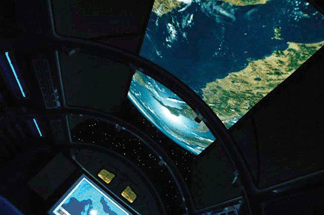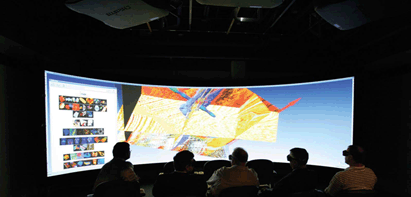Integrators Are Thinking Outside The Box With Aspect Ratios While airplanes themselves may not be fertile ground for many AV integrators, the need to train, educate, and qualify those who pilot them has, quite literally, broadened our industry’s horizons. For it was the need, back in the 1970s, to simulate the view from a pilot’s cockpit that first obligated projector and screen manufacturers to think ‘outside the box’ (to use a very
Stewart Filmscreen works directly with consultants and integrators—and often architects—on applications that require extra-wide screens. non-1970s phrase) and design hardware for super- wide aspect ratios.
Don Stewart, partner and executive VP, Stewart Filmscreen, believes that flight simulation was “the first application that really required the output of three, four, or five projectors to be edge-blended together to make a seamless image—though in those days, of course, they would have been CRT projectors.”
Stewart Filmscreen developed Aeroview, its first screen material specifically designed for edge-blending, in the late 1990s, and has never looked back. Over the past few years the company has built up a wealth of experience working in applications that require extra-wide screens, which is an important consideration when you consider the individual nature of each project.
“Usually these will be bespoke products,” Stewart explained. “There’ll be a consultant involved and an integrator, and perhaps an architect as well. One of the reasons we’ve been successful is that we have those relationships, and we have a whole team of engineers, not just sales people, who are aware of the processes that need to be gone through to realize these projects.”
LIFT-OFF
The custom approach to large screens also appeals to Dennis Pacelli, VP sales and marketing, Harkness Screens, which recently bent over backwards—again, quite literally—to supply three 20- by 38-foot rear-projection screens, plus custom frames about four feet larger, to the new Shuttle Launch Experience attraction at NASA’s Kennedy Space Center Visitor Complex.
“The ‘Shuttle’ posed a lot of challenges,” Pacelli said. “The screens were 70 feet in the air, which caused installation issues, not just with the screens but with the frames as well. Our solution was to put the screen on a roller so that once the frame was winched up into place, the screen could be dropped into it like a window shade, then pulled down and laced into place.
“The creative people involved in these attractions have visions, and we don’t mind—we just do our best to meet their expectations and make sure that it’s done right.”
In a modern-day version of those first flight simulators, visitors to the Shuttle Launch Experience are strapped into their seats as if they were crewmembers, and then taken on a four-minute ride through ‘space’, culminating in a 63-degree tiltback that abruptly ceases. At this point, the Shuttle’s cargo bay doors open and the passengers are tilted slightly forward to see a spectacular view of planet Earth, just as real-life NASA astronauts would see it, thanks to the Harkness screen. (There are three Shuttle simulators in all—hence the need for three screens.)
The systems integrator for the Shuttle Launch Experience, Technomedia Solutions, called on design engineering company Poggi Designs for technical assistance when it came to the simulators’ screen design. “The show producer, Bob Rogers, knew what he wanted to do, but then it became a case of: How do we do this?” said Emil Poggi, COO of Poggi Designs. “That’s where we got involved, and Harkness got involved, and we started from there, going all the way to a full-size mock-up in a NASA building once used for Apollo rocket assemblies. We could prove the concept mathematically, but we also had to show the customer that the ride would work from an audience perspective.”

Harkness Screens recently supplied three 20- by 38-foot rear-projection screens, plus custom frames about four feet larger, to the new Shuttle Launch Experience attraction at NASA’s Kennedy Space Center Visitor Complex. screen isn’t going to do a whole lot.”
TESTING LIMITS
Don Stewart sees a different kind of driver for the growth of extraordinary screens—one that has more to do with professional or government concerns than those of the leisure industry. “We are doing a lot of retro-fitting of seamless screens with edge-blending into command and control, where they are replacing walls of video cubes,” Stewart said. “The beauty of that is that you no longer have a border around each screen, and the demand for it is growing because we now have so much information available to us that in order to make sense of it, you have to be able to display multiple images in a smooth fashion.”
There is no obvious limit, Stewart believes, to the amount of visual information that a state or national security installation, for example, will want to display on a single, seamless screen, or to the extent to which such facilities will want to ‘drill down’ into their data—super-magnifying images from satellites, for example. There are limits, however, to how easily our eyes will be tricked by edge-blending into seeing multiple projections as a single image. As Harkness Screens’ Dennis Pacelli points out, the relationship of the viewer to the screen is a key consideration here: “You need to think about the environment that the system will be viewed in. If it’s dark, and people are moving along and past the screen on their way to other attractions, then you need a unity-gain screen so that the image doesn’t get brighter or dimmer as you pass it.”
On the other hand, if viewers are likely to be in a fixed position in relation to the screen—in an auditorium or a control room, for example— then the key issue becomes minimizing any multiple-image artifacts. “Edge-blending works best with an odd number of projectors,” said Don Stewart. “With two projectors, the edge is right in the center of the image and that’s where your eye goes all the time. Also, the wider the halfgain angle, where the screen drops below 50 percent of its highest luminance, the better the edge-blending transitions are going to be.”
Ultimately, whether these screens are super-wide or almost square, and whether they are being fired at from front or rear, by single or multiple projectors, one constant remains: a finely honed projection system on its own is not enough to guarantee endcustomer satisfaction.
“The content has to be something that stimulates people,” concludes Emil Poggi. “The NASA project doesn’t use a huge screen, but it’s deployed in such a way that you really want to look at it. So you need a combination of things: the right dimensions and the right content.”
